INSTITUT SUPERIEUR D'ANTHROPOLOGIE
INSTITUTE OF ANTHROPOLOGY
ONLINE COURSES / COURS A DISTANCE
FALL TERM : OCTOBER 2015
REGISTER NOW
INDE – 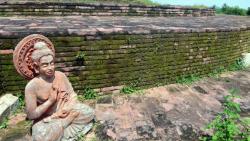 Dhulikatta - The Buddhist Stupa dating back to 2nd century BC and one of the 30 walled cities mentioned by Megasthenes located in Dhulikatta village of Eligaid mandal in Karimnagar district lies neglected for several decades due to lethargy on the part of the government. The Archaeology Department had discovered the heritage structure in 1975 along the shores of a picturesque rivulet on the outskirts of Dhulikatta village. Barring the discovery of this early Buddhist stupa, the authorities have failed to take up any measures for the development and protection of the heritage site for the promotion of tourism. This Buddhist Stupa was constructed on a mound with light weight bricks. It is embellished with sculpted veneer slabs and beautifully carved limestone slabs. It is stated that site had attained importance as it was constructed with 47 slabs to enhance the dome with the Stupa. Historians say that the Archaeology authorities had discovered other relics such as gateways built with light weight bricks, mahastupa, chatra, residential houses, wells, bangle pieces, ivory combs, gold objects, punch-marked coins, beads, coins of Romans and Satavahanas and seals. Majority of relics were shifted to the present Andhra Pradesh State Museum and only a few antiques lie in the Karimnagar museum.
Dhulikatta - The Buddhist Stupa dating back to 2nd century BC and one of the 30 walled cities mentioned by Megasthenes located in Dhulikatta village of Eligaid mandal in Karimnagar district lies neglected for several decades due to lethargy on the part of the government. The Archaeology Department had discovered the heritage structure in 1975 along the shores of a picturesque rivulet on the outskirts of Dhulikatta village. Barring the discovery of this early Buddhist stupa, the authorities have failed to take up any measures for the development and protection of the heritage site for the promotion of tourism. This Buddhist Stupa was constructed on a mound with light weight bricks. It is embellished with sculpted veneer slabs and beautifully carved limestone slabs. It is stated that site had attained importance as it was constructed with 47 slabs to enhance the dome with the Stupa. Historians say that the Archaeology authorities had discovered other relics such as gateways built with light weight bricks, mahastupa, chatra, residential houses, wells, bangle pieces, ivory combs, gold objects, punch-marked coins, beads, coins of Romans and Satavahanas and seals. Majority of relics were shifted to the present Andhra Pradesh State Museum and only a few antiques lie in the Karimnagar museum.
http://www.thehindu.com/news/national/telangana/buddhist-stupa-lies-in-neglect/article7679926.ece
INDE –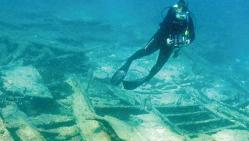 Dwarka - Could the history of Sangam Era be reconstructed through Marine Archaeology? Yes, say historians, who are urging the state government to take up initiative to trace the missing link of Tamil history — by launching research to find the lost underground ancient Tamil era cities like Poompuhar, and the presumed lost continent in the Indian Ocean, Kumari Kandam. Addressing a press conference, regional director of Archaeological Survey of India (ASI), D Dayalan, who was part of the team to excavate the ancient city of Dwarka, and director of Indian Science Monitor TKV Rajan, said that it was time the state government supported research efforts. In the 80s, when India made a modest effort to establish Marine Archaeology Centre at National Institute of Oceanography (NIO), the infrastructure was provided by NIO, and initial grants came from Indian National Science Academy and Department of Science and Technology, and subsequently from the Centre for Scientific and Industrial Research. Even the then State government under the leadership of MGR had backed the effort to trace the history of ancient city of Poompuhar, which was under water. “The effort that began in 1986 was shelved in 1996. We don’t have any clue as to why we did not receive any backing after that,” said Rajan. Rajan and Dayalan are keen to revive marine archaeology to trace the missing link of Tamil history underwater, expressing hope that excavations could be carried out in Kaveri Poompuhar near Sirkazhi. “Private agencies are ready to fund the project. All we require is the backing of state government, and the Ministry of External Affairs’ clearance to take up the project,” he said. The historians are planning to use NIOT ship, which Rajan claims had traced the antiquities in Poompuhar four times. But how are they going to trace the sites that they believe are under water? “This could be done through satellite imaging as well as site scan cameras, which can trace the antiquities available under the ocean. We would also get help from National Geophysical Research Institute in Hyderabad provided we get clearance from the Union government,” said Rajan. “We can also take the help of France, which has the expertise in marine archaeology.” The ASI is also planning to identify ship wrecks in Indian and international waters. The plan is to identify the ship wrecks that happened 1,300 to 1,400 years ago. “We are trying to locate the ship wrecks during the Chola era as Malaya was conquered by Rajendra,” said Dayalan. “Without the help of Indian Navy we can’t do it. It is very expensive.”
Dwarka - Could the history of Sangam Era be reconstructed through Marine Archaeology? Yes, say historians, who are urging the state government to take up initiative to trace the missing link of Tamil history — by launching research to find the lost underground ancient Tamil era cities like Poompuhar, and the presumed lost continent in the Indian Ocean, Kumari Kandam. Addressing a press conference, regional director of Archaeological Survey of India (ASI), D Dayalan, who was part of the team to excavate the ancient city of Dwarka, and director of Indian Science Monitor TKV Rajan, said that it was time the state government supported research efforts. In the 80s, when India made a modest effort to establish Marine Archaeology Centre at National Institute of Oceanography (NIO), the infrastructure was provided by NIO, and initial grants came from Indian National Science Academy and Department of Science and Technology, and subsequently from the Centre for Scientific and Industrial Research. Even the then State government under the leadership of MGR had backed the effort to trace the history of ancient city of Poompuhar, which was under water. “The effort that began in 1986 was shelved in 1996. We don’t have any clue as to why we did not receive any backing after that,” said Rajan. Rajan and Dayalan are keen to revive marine archaeology to trace the missing link of Tamil history underwater, expressing hope that excavations could be carried out in Kaveri Poompuhar near Sirkazhi. “Private agencies are ready to fund the project. All we require is the backing of state government, and the Ministry of External Affairs’ clearance to take up the project,” he said. The historians are planning to use NIOT ship, which Rajan claims had traced the antiquities in Poompuhar four times. But how are they going to trace the sites that they believe are under water? “This could be done through satellite imaging as well as site scan cameras, which can trace the antiquities available under the ocean. We would also get help from National Geophysical Research Institute in Hyderabad provided we get clearance from the Union government,” said Rajan. “We can also take the help of France, which has the expertise in marine archaeology.” The ASI is also planning to identify ship wrecks in Indian and international waters. The plan is to identify the ship wrecks that happened 1,300 to 1,400 years ago. “We are trying to locate the ship wrecks during the Chola era as Malaya was conquered by Rajendra,” said Dayalan. “Without the help of Indian Navy we can’t do it. It is very expensive.”
http://www.newindianexpress.com/cities/chennai/Use-Marine-Archaeology-to-Trace-Sangam-Era-History/2015/09/23/article3041905.ece#
PEROU – 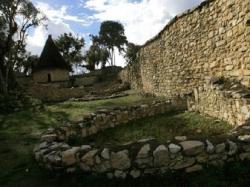 Chachapoya - The Chachapoya region, including Kuelap, is an archaeological treasure, says ABC.net. “Approximately 90 per cent of Chachapoyan archaeology is undiscovered,” Peter Lerche, historian and former mayor of the provincial capital of Chachapoyas told ABC.net. “Every week you could have a new story about a newly discovered site.” There are no plans to invest in the excavation, restoration or consolidation of Kuelap, which was maybe 5 per cent excavated,
Chachapoya - The Chachapoya region, including Kuelap, is an archaeological treasure, says ABC.net. “Approximately 90 per cent of Chachapoyan archaeology is undiscovered,” Peter Lerche, historian and former mayor of the provincial capital of Chachapoyas told ABC.net. “Every week you could have a new story about a newly discovered site.” There are no plans to invest in the excavation, restoration or consolidation of Kuelap, which was maybe 5 per cent excavated,
http://www.peruthisweek.com/news-approximately-90-per-cent-of-chachapoyan-archaeology-is-undiscovered-says-historian-107640
IRLANDE –  Cork - The long lost remains of Thomas Kent, one of the 16 men executed in 1916 following the Easter Rising, have been identified by scientific DNA analysis. The remains were exhumed in Cork Prison in June 2015. They were discovered in a shallow grave, filled with quicklime. As no formal records were available, after 99 years, the only way to be sure that they were the remains of Thomas Kent was to conduct scientific DNA analysis. Thomas Kent, and his brother William, were arrested following a RIC raid at the family home on 2 May 1916. Richard, their brother, was wounded trying to escape and died shortly after. Thomas and William were tried by courts-martial at Cork Detention Barracks. William was acquitted, but Thomas was sentenced to death and was executed in Cork on 9th May 1916.
Cork - The long lost remains of Thomas Kent, one of the 16 men executed in 1916 following the Easter Rising, have been identified by scientific DNA analysis. The remains were exhumed in Cork Prison in June 2015. They were discovered in a shallow grave, filled with quicklime. As no formal records were available, after 99 years, the only way to be sure that they were the remains of Thomas Kent was to conduct scientific DNA analysis. Thomas Kent, and his brother William, were arrested following a RIC raid at the family home on 2 May 1916. Richard, their brother, was wounded trying to escape and died shortly after. Thomas and William were tried by courts-martial at Cork Detention Barracks. William was acquitted, but Thomas was sentenced to death and was executed in Cork on 9th May 1916.
VIDEO = http://www.ucd.ie/newsandopinion/news/dnaanalysisidentifieslong-lostremainsofexecuted1916rebel/
USA – 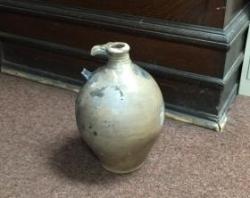 Savannah - An archaeological mystery was recently unearthed behind Savannah’s City Hall. Contractors working for Georgia Power on the new ferry shelter landing on Rousakis Plaza found an intact jug buried six feet down in their construction site. The jug was handed over to the City’s Research Library & Municipal Archives department, which will be working with local experts to determine when the jug was made and what purpose it might have served. Based on the location, City staff thinks the jug might date back to when the port of Savannah was located along River Street, and it could’ve been an item that was imported or exported through the port. Inside the jug is a dark, oily substance that smells fishy, so perhaps it stored fish oil. The jug appears to feature a salt glaze and exhibits throw marks around the neck and base. There are no visible potter’s marks.
Savannah - An archaeological mystery was recently unearthed behind Savannah’s City Hall. Contractors working for Georgia Power on the new ferry shelter landing on Rousakis Plaza found an intact jug buried six feet down in their construction site. The jug was handed over to the City’s Research Library & Municipal Archives department, which will be working with local experts to determine when the jug was made and what purpose it might have served. Based on the location, City staff thinks the jug might date back to when the port of Savannah was located along River Street, and it could’ve been an item that was imported or exported through the port. Inside the jug is a dark, oily substance that smells fishy, so perhaps it stored fish oil. The jug appears to feature a salt glaze and exhibits throw marks around the neck and base. There are no visible potter’s marks.
http://savannahnow.com/latest-news/2015-09-23/archaeological-mystery-unearthed-behind-city-hall?
ROYAUME UNI – 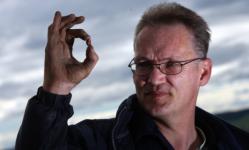 Perth - An archaeological dig on a hill near Perth has made a significant find which may rewrite the area’s ancient history. Although still to be confirmed, the group of mainly volunteers believe they have unearthed a broch or Iron Age stone tower. “It is exciting news and quite important, it would be only the third broch discovered in Perth and Kinross,” said David Strachan from Perth and Kinross Heritage Trust who is leading the dig for the Tay Landscape Partnership (TayLP). The first local broch was only discovered in 2009 at Dunsinane Hill with a second later identified at Craig Rossie. If Moncreiffe turns out to be another broch, it will be of great interest to historians and archaeologists as these drystone towers are peculiarly Scottish and are rare survivors of the Iron Age. Why the Moncreiffe Hill site would have been chosen is no mystery to the dig team. The ancient seat of power would have provided commanding views down over the rivers Tay and Earn for the prehistoric occupants of the broch and been an excellent spot to defend. The intention was to evaluate the site, work out the scale and nature of what is there with the intention of coming back next year for further excavations. The investigation of the Moredun Top Hillfort has revealed there are actually three forts on top of each other indicating the length of occupation of the site. The dig has also revealed day to day objects which are described as “occupational evidence” such as a bead, a possible piece of bracelet, bits of animal bone and charcoal.
Perth - An archaeological dig on a hill near Perth has made a significant find which may rewrite the area’s ancient history. Although still to be confirmed, the group of mainly volunteers believe they have unearthed a broch or Iron Age stone tower. “It is exciting news and quite important, it would be only the third broch discovered in Perth and Kinross,” said David Strachan from Perth and Kinross Heritage Trust who is leading the dig for the Tay Landscape Partnership (TayLP). The first local broch was only discovered in 2009 at Dunsinane Hill with a second later identified at Craig Rossie. If Moncreiffe turns out to be another broch, it will be of great interest to historians and archaeologists as these drystone towers are peculiarly Scottish and are rare survivors of the Iron Age. Why the Moncreiffe Hill site would have been chosen is no mystery to the dig team. The ancient seat of power would have provided commanding views down over the rivers Tay and Earn for the prehistoric occupants of the broch and been an excellent spot to defend. The intention was to evaluate the site, work out the scale and nature of what is there with the intention of coming back next year for further excavations. The investigation of the Moredun Top Hillfort has revealed there are actually three forts on top of each other indicating the length of occupation of the site. The dig has also revealed day to day objects which are described as “occupational evidence” such as a bead, a possible piece of bracelet, bits of animal bone and charcoal.
http://www.thecourier.co.uk/news/local/perth-kinross/archaeologists-unearth-rare-find-on-perthshire-hilltop-1.901662?
RUSSIE – 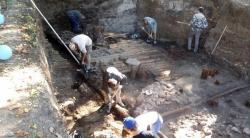 Moscou - Scientists digging at the site of a demolished hotel in the heart of Moscow have unearthed the oldest street archeologists have ever had a chance to study, they report. The medieval street connected the Kremlin with the bank of the Moskva River. The find is located in a historic city area called Zaryadye, east of the Kremlin. The name means ‘behind the rows’ and refers to the marketplace that was next to the fortress. Wealthy merchants and warriors lived there and did business. The area saw demolishing and massive construction effort in the 1930s that completely changed Zaryadye and left behind a formidable foundation from an abandoned project of a gigantic ministerial building.In 1967, the infamous Rossiya Hotel was constructed on that foundation, but after decades of service the Moscow authorities decided to demolish it in 2007. With the gigantic building gone, archeologists got a chance to excavate one of the oldest parts of the Russian capital. The dig produced a trove of historic artifacts from the medieval times, when Zaryadye was a major trade hub in Moscow, scientists of the Archeology Institute of the Russian Academy of Sciences reported Wednesday. Those include what used to be the street called Velikaya (Great), which led from the Kremlin to a pier on the Moskva River to the south. The 6.5-meter-wide street appeared on the maps during the early stages of the city’s expansion in 12th-13th centuries. The upper layers of the dig revealed logs and pavement stones from 17th-18th centuries – but below them are logs from earlier centuries. The find will help the researchers compile a dendrochronology chart for old Moscow, a challenge that remained elusive for several decades.
Moscou - Scientists digging at the site of a demolished hotel in the heart of Moscow have unearthed the oldest street archeologists have ever had a chance to study, they report. The medieval street connected the Kremlin with the bank of the Moskva River. The find is located in a historic city area called Zaryadye, east of the Kremlin. The name means ‘behind the rows’ and refers to the marketplace that was next to the fortress. Wealthy merchants and warriors lived there and did business. The area saw demolishing and massive construction effort in the 1930s that completely changed Zaryadye and left behind a formidable foundation from an abandoned project of a gigantic ministerial building.In 1967, the infamous Rossiya Hotel was constructed on that foundation, but after decades of service the Moscow authorities decided to demolish it in 2007. With the gigantic building gone, archeologists got a chance to excavate one of the oldest parts of the Russian capital. The dig produced a trove of historic artifacts from the medieval times, when Zaryadye was a major trade hub in Moscow, scientists of the Archeology Institute of the Russian Academy of Sciences reported Wednesday. Those include what used to be the street called Velikaya (Great), which led from the Kremlin to a pier on the Moskva River to the south. The 6.5-meter-wide street appeared on the maps during the early stages of the city’s expansion in 12th-13th centuries. The upper layers of the dig revealed logs and pavement stones from 17th-18th centuries – but below them are logs from earlier centuries. The find will help the researchers compile a dendrochronology chart for old Moscow, a challenge that remained elusive for several decades.
http://www.rt.com/news/316287-oldest-street-moscow-found/?
GRECE – 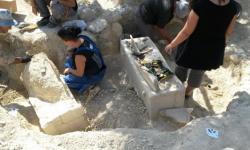 Moni - A rock-cut tomb of the Late Minoan period (around 1300 BC) was located in a rural area near the village of Moni in Malevisi near Heraklion of northern Crete. This is the second tomb found in the surrounding area of the village Moni. The first was revealed in June 2014, during construction work of a biological treatment unit. The mass grave contained clay sarcophagi, pottery and several other finds. During the rescue excavation conducted by the archaeologists two large clay sarcophagi came to light, grave goods such as pots and other small artefacts. The findings have been transferred to the laboratories of the archaeological ephorate to be analyzed and conservated.
Moni - A rock-cut tomb of the Late Minoan period (around 1300 BC) was located in a rural area near the village of Moni in Malevisi near Heraklion of northern Crete. This is the second tomb found in the surrounding area of the village Moni. The first was revealed in June 2014, during construction work of a biological treatment unit. The mass grave contained clay sarcophagi, pottery and several other finds. During the rescue excavation conducted by the archaeologists two large clay sarcophagi came to light, grave goods such as pots and other small artefacts. The findings have been transferred to the laboratories of the archaeological ephorate to be analyzed and conservated.
http://www.archaeology.wiki/blog/2015/09/23/minoan-tomb-clay-sarcophagi-found-northern-crete/